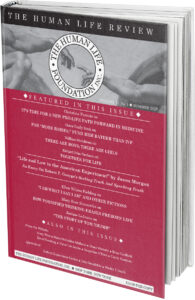Unforgettable
In October, Christie’s will auction off a portrait of Edmond de Belamy, estimated to sell for between $8,000 and $11,500. Edmond de Who? If the name doesn’t sound familiar, that’s because Edmond de Belamy has never existed. Neither have the members of his extended “family,” ancestors and immediate relatives all of whom are featured in portraits tracing the Belamy line. Edmond de Belamy is a figment, a computer-generated image that is being touted as the latest and most impressive example of artificial intelligence, or AI.
But is Edmond de Belamy really the creation of an intelligent non-human being? The picture was made when a three-member French art group that calls itself Obvious fed 15,000 images—portraits from the fourteenth to the twentieth centuries—into an algorithm known as GAN, which was written in 2014 by an American AI researcher named Ian Goodfellow. The algorithm averaged out characteristics from all the paintings, blending the colors and lines and rearranging the poses and the backgrounds to generate “new” paintings based on these averages. But these are not works of art, they’re just composites, software-induced collages of real artworks by thousands of real human beings. In other words, in their entirety, the images of Edmond and his family were made by humans, not computers. This is not artificial intelligence. It’s just artifice.
Why do we do this? And why would we hide our creativity? One clue may come from the work of Supasorn Suwajanakorn, a recently-minted PhD from the Graphics-Vision program at the University of Washington. Dr. Suwajanakorn asks:
Can you create a computer model of anyone that looks, talks, and acts just like them by analyzing their existing photos and videos? […] I developed a set of algorithms that can generate a “moving” 3D face model out of just photos, synthesize high-quality facial textures with dynamic creases and wrinkles, capture and transfer facial expressions, and generate videos of a person from their voice, and more.

The portrait of Edmond de Belamy
Or, as a recent New York Post article has it:
A new method in “deepfakes” can take the “style” or “likeness” of one person or object and transfer it to another. […] Deepfakes are fake videos that have been manipulated by artificial intelligence to make someone or something appear as something else.
“Style” and “likeness” are in scare quotes here for a good reason: They’re being used equivocally. Style and likeness are not compatible with “deepfaking.” Verisimilitude is not essence, it is mimicry, the recreation of something to give it the appearance of the real thing, but without having gotten to its living core.
In a human being, this living core has traditionally been called a soul. It is the principle of the person, the thing that makes us who we are. And it is unrepeatable, utterly unique. Souls cannot be averaged or faked, blended into composites or smudged into layered collages like Edmond de Belamy. Souls are received as gifts, and they are nontransferable to any other medium. This whole package—this is us, this is me.
However, in our age of hoarding, Big Data, and virtually seamless video surveillance, the soul is the one thing we have thrown away, been unable to digitally store, and found impossible to track. We don’t like to admit it, but deep down we know it’s true. We can’t find the soul using science, so ever since the Enlightenment we have shouted that it doesn’t exist. Imagine the loneliness of a “soulless” world. We deny the existence of the soul, but secretly—desperately—wish to discover that we are more than sweepings of atoms from the void. This is why we rush like mad to embrace so-called artificial intelligence: We are hoping to find in our Edmond de Belamys and other 21st-century Frankensteins the metaphysical spark we have doused in ourselves.
The auctioning of the Edmond de Belamy portrait reminds me, of all things, of a music video from the 1990s: “Unforgettable,” a duet sung by Natalie Cole and her dead father, the great Nat King Cole. In the video, which was revolutionary at the time, Natalie Cole reprises her father’s hit song while singing in sync with a recording of his voice. Forty years after the original “Unforgettable” went to the top of the charts, clever video editing creates the impression that Nat King Cole is crooning (in real time) along with his daughter.
Nat King Cole was not the product of an algorithm. Until 1965, he was a soul united to a body. It was Nat King Cole, the real, live man, whom his daughter longed to see again, declared she could never forget. She looked for him in this world, but knew he was no longer here. His soul was what she longed for, but his soul had gone somewhere else.
Many today do not believe we have souls. Practical atheism, though, is leading us to try to locate in computer simulacra the souls that we so ardently deny in ourselves.
Let us not be confused over what AI really is. It is not a new kind of lifeform or an independent intelligence. Nor is it a substitute for humanity. It is simply who we are projected through a binary fog. It is a longing for eternal life from within the confines of a culture that scoffs at such a thing. Even the name “Edmond Belamy” confesses this truth. As another New York Post article reports: “the fictional Belamy family [is] named after Ian Goodfellow . . . ‘Goodfellow’ roughly translates to ‘bel ami’ in French.” In its portrait of Edmond, the French team is trying to get Ian—it is always the soul of a person we want to reach.
Somehow, AI ends up looking a lot like la recherche du temps perdu. In our strange algorithmic reincarnations, we come back around to meet ourselves as digital avatars, seeking assurance that the loneliness of the post-Christian West is not the result of our having thrown away our humanity—and then forgotten that we did.









